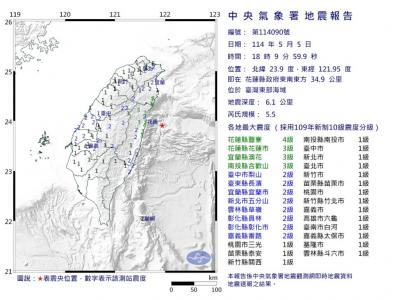The Ministry of National Defense yesterday refused to comment on a report in the Chinese Communist Party-run Guangming Daily saying that the Kuang Hua VI (KH-6) fast attack missile boats that have been in service in the Taiwanese navy since 2010 were plagued by deficiencies and were a “fantasy.”
Taiwan commissioned its first squadron of 11 KH-6 radar-evading fast-attack craft, produced by China Shipbuilding Corp, in May 2010. Since then, 20 more of the 170-tonne boats have entered service, the most recent 10 on Dec. 2 last year at Tsuoying Naval Base in Greater Kaohsiung.
The 31 boats comprise the navy’s three squadrons, which have been dubbed Hai Chiao (Sea Sharks).

Photo: Chang Chung-i, Taipei Times
Each boat, which costs about US$12.3 million, comes equipped with four Hsiung Feng II anti-ship missiles with a range of 150km, as well as a 20mm anti-aircraft gun, a 7.62mm machine gun and decoy systems.
The KH-6s, which have gradually been replacing the Navy’s Israeli-made Hai Ou (Sea Gull)-class missile patrol boats, are integral to the defense of Taiwan’s waters. Given the narrowness of the Taiwan Strait, the boats would be able to attack targets at naval bases along China’s coast.
Some naval experts, including James Holmes of the US Naval War College, have hailed the capabilities of fast-attack craft as a potentially efficient asymmetrical counter to the growing Chinese military.
The Hsiung Feng III, currently under development by the Chung Shan Institute of Science and Technology, is also a main component of Taiwan’s emerging sea defenses.
However, the Guangming Daily on Tuesday claimed that the program was beset with problems and called the Sea Sharks a “fantasy.” At issue, the paper said, was the fact that the guns on the KH-6 needed to be operated manually, which undermined the craft’s “stealth” capability.
The article also said the craft was ill-suited for the rough weather conditions in the Taiwan Strait, pointing to an incident involving a prototype that lost power and became stranded on an outer seawall during Typhoon Jangmi in September 2008.
In all, the paper said, those deficiencies imposed “several restrictions” on the boats’ use.
Contacted by the Taipei Times yesterday, Ministry of National Defense spokesperson Colonel David Lo (羅紹和) said the ministry would not comment on Chinese media reports on Taiwan’s weapons systems.
Asked for comment, Holmes said the navy probably had corrected any deficiencies that lend themselves to easy fixes, such as clutter on the main deck.
“The point about handling well in heavy weather or at sea, however, is not something so easily corrected,” he said via e-mail. “The vessel is top-heavy because of its tall superstructure, which raises its ‘center of buoyancy’ and makes it bob around like a cork in high seas. That compromises its ability to go to sea and fight in all weather.”
“Improving the KH-6’s seakeeping ability would require a major redesign to lower weight within the vessel. That’s not something so easily solved,” Holmes said.
“Calling the craft a ‘fantasy’ overstates things in my view, so our Chinese friends could be indulging in some triumphalism. But I certainly see the KH-6 as only a transitional platform until something better is in the water,” he added.
Wendell Minnick, the Taipei-based Asia bureau chief for Defense News, said the deficiencies mentioned in the article were old ones and that he suspected the navy had ironed most of them out by now.
“The KH-6 missile patrol boat program has experienced developmental problems. One main problem is balancing the weight of larger missiles across the frame,” Minnick told the Taipei Times yesterday. “This has caused some problems in the past, but they appear to be seaworthy at present.”
“For the most part, Taiwan does produce, at the end of the day, impressive weapon systems and in many ways the Taiwanese are some of the best weapons producers in the world,” he said.

The brilliant blue waters, thick foliage and bucolic atmosphere on this seemingly idyllic archipelago deep in the Pacific Ocean belie the key role it now plays in a titanic geopolitical struggle. Palau is again on the front line as China, and the US and its allies prepare their forces in an intensifying contest for control over the Asia-Pacific region. The democratic nation of just 17,000 people hosts US-controlled airstrips and soon-to-be-completed radar installations that the US military describes as “critical” to monitoring vast swathes of water and airspace. It is also a key piece of the second island chain, a string of

A magnitude 5.9 earthquake that struck about 33km off the coast of Hualien City was the "main shock" in a series of quakes in the area, with aftershocks expected over the next three days, the Central Weather Administration (CWA) said yesterday. Prior to the magnitude 5.9 quake shaking most of Taiwan at 6:53pm yesterday, six other earthquakes stronger than a magnitude of 4, starting with a magnitude 5.5 quake at 6:09pm, occurred in the area. CWA Seismological Center Director Wu Chien-fu (吳健富) confirmed that the quakes were all part of the same series and that the magnitude 5.5 temblor was

Taiwan will now have four additional national holidays after the Legislative Yuan passed an amendment today, which also made Labor Day a national holiday for all sectors. The Chinese Nationalist Party (KMT) and Taiwan People’s Party (TPP) used their majority in the Legislative Yuan to pass the amendment to the Act on Implementing Memorial Days and State Holidays (紀念日及節日實施辦法), which the parties jointly proposed, in its third and final reading today. The legislature passed the bill to amend the act, which is currently enforced administratively, raising it to the legal level. The new legislation recognizes Confucius’ birthday on Sept. 28, the

The Central Weather Administration has issued a heat alert for southeastern Taiwan, warning of temperatures as high as 36°C today, while alerting some coastal areas of strong winds later in the day. Kaohsiung’s Neimen District (內門) and Pingtung County’s Neipu Township (內埔) are under an orange heat alert, which warns of temperatures as high as 36°C for three consecutive days, the CWA said, citing southwest winds. The heat would also extend to Tainan’s Nansi (楠西) and Yujing (玉井) districts, as well as Pingtung’s Gaoshu (高樹), Yanpu (鹽埔) and Majia (瑪家) townships, it said, forecasting highs of up to 36°C in those areas